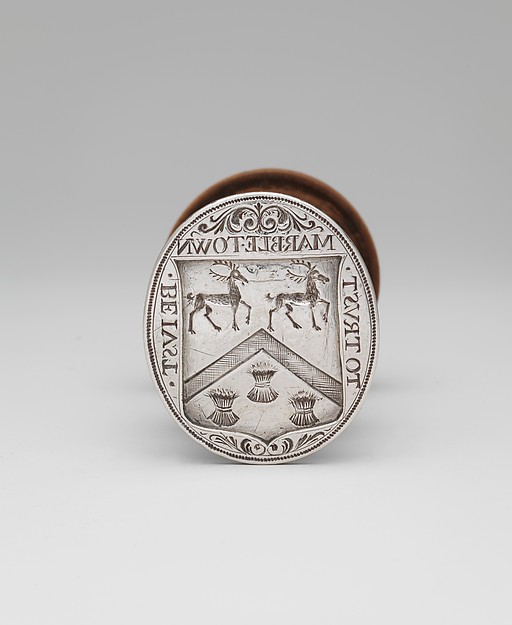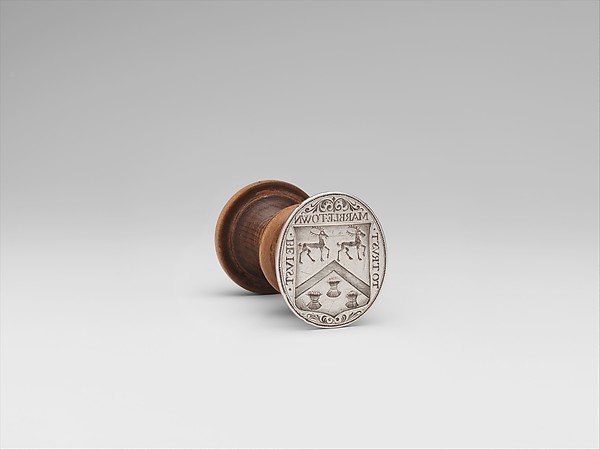By Neil Gandhi, Fangling He, and Jarisha Olanday from Section 2

This seal was created by Dutch silversmith Jacob Boelen in 1704 as an official town seal for Marbletown, New York, used to stamp official documents. The head of the seal is made of official silver that is placed on top of a wooden handle. Engraved on the seal is the town’s coat of arms. The upper region of the coat of arms above the chevron, are two deer that symbolize the town’s hilly uplands and mountainous surroundings that served as hunting areas. Below the chevron are three sheaves of wheat that symbolize the surrounding fertile lowland that suited the cultivation of grains. Above the shield is a reversed engraving of “MARBLETOWN”. On the sides of the shield is a reversed engraving of the town’s motto “BE IVST(left)/ TO TRVST(right)”, or “Be Just To Trust”.


The seal is currently located in The Metropolitan Museum of Art, specifically The Met Fifth Avenue. The seal was previously located in Kingston, New York and owned by Alphonso T. Clearwater since 1925. In cooperation with Marbletown, the seal was bequest by Clearwater to the Met in 1933.
The Story of the Seal
The seal tells us about two things: the story of its creator and the story of why it was created.
Jacob Boelen, the creator of the seal, is a notable Dutch silversmith who was born in Amsterdam, Netherlands in 1645. He worked as a silversmith in New York City, NY from 1660 to his death. Many of his surviving works, like this seal, is exhibited today in the Metropolitan Museum of Art, Yale University, and the Museum of the City of New York. His beautiful silver work range from spoons, various cups, teacups, tankards, and, of course, this seal.
The seal was created in 1704, a year after Marbletown received its patent on June 25th, 1703. A group of Americans and Dutchmen applied for the patent and was granted by Col. Henry Beekman, Capt. Thomas Garton and Capt. Charles Brodhead in trust for the inhabitants. After the city of Kingston (the first capital of NY, northeast of Marbletown) was burned by the British during the American Revolution in 1777, Marbletown briefly served as the states capital. The Town of Marbletown was officially formed in 1844, after regions of the land were used to form the Town of Olive(1823) and the Town of Rosendale(1844). Marbletown was heavily influenced by the Dutch which is evident through its architectural heritage and its districts (like Kripplebush – that is definitely Dutch!).
What does it tell us today?
The seal is still a great symbol of Marbletown, New York today. Much of the rural community is underdeveloped, leaving a scenic landscape of mountains and fertile land, just as the seal’s coat of arms still depicts. Marbletown retains its history and architectural heritage through a sprinkling of many historical zones across the region. Within Marbletown are four locations that are registered in the National Register of Historic Places: Bevier Stone House, Rest Plaus Historic District, Cornelius Wynkoop Stone House, and Kripplebush.
The surviving architecture in these districts, many of it made of stone, embody Dutch vernacular architecture of the 17th and 18th century. Additionally, some districts and places of Marbletown are agriculturally centered; its 19th century and early 20th century framed community institutions, rural domestic, manufacturing and commercial buildings embody the town’s expansive involvement in agricultural enterprises. Its build environment genuinely preserves this rural neighborhood’s historic growth and accompanying changes in land ownership and new construction through a range of domestic, commercial, and institutional structures. In this fashion, through its distinct inscriptions and motto, the seal remains symbolic to Marbletown’s historic identity.
We decided to pick this object because it represents a town that was originally founded by the Dutch. It is important to remember many towns in the Northeast were founded by Dutch settlers way before the English ever got there and that the Dutch play a huge part in our history. This seal is a very simple object that signifies a lot and has a lot of symbolic meaning behind it. Usually, when we think about any kind of seal, we do not stop and think about all of the meaning and history behind it. This artifact that made us realize how much history and the amount of significance such a small and simple artifact can have.
Resources:
- http://www.metmuseum.org/art/collection/search/7364
- http://www.marbletown.net/community/our-history/
- https://en.wikipedia.org/wiki/Marbletown,_New_York
- http://freepages.genealogy.rootsweb.ancestry.com/~silversmiths/makers/silversmiths/68734.htm
